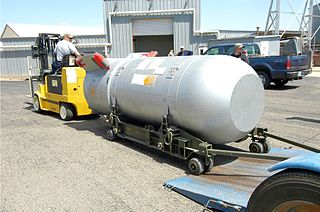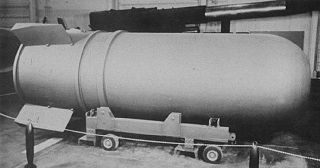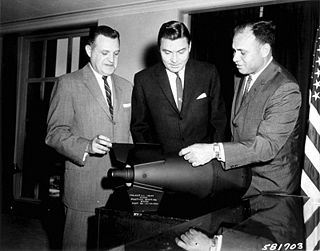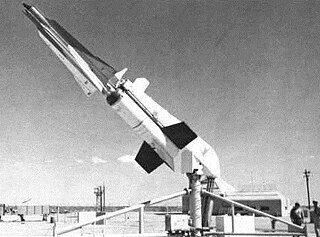Related Research Articles

The Boeing AGM-69 SRAM was a nuclear air-to-surface missile. It had a range of up to 110 nautical miles, and was intended to allow US Air Force strategic bombers to penetrate Soviet airspace by neutralizing surface-to-air missile defenses.

Operation Plumbbob was a series of nuclear tests that were conducted between May 28 and October 7, 1957, at the Nevada Test Site, following Project 57, and preceding Project 58/58A.

The Mk/B53 was a high-yield bunker buster thermonuclear weapon developed by the United States during the Cold War. Deployed on Strategic Air Command bombers, the B53, with a yield of 9 megatons, was the most powerful weapon in the U.S. nuclear arsenal after the last B41 nuclear bombs were retired in 1976.

The B-41 was a thermonuclear weapon deployed by the United States Strategic Air Command in the early 1960s. It was the most powerful nuclear bomb ever developed by the United States, with a maximum yield of 25 megatons of TNT. A top secret document, states “The US has stockpiled bombs of 9 MT and 23 MT...” which would likely be referring to the B-41's actual yield(s). The B-41 was the only three-stage thermonuclear weapon fielded by the U.S.
The W69 was a United States nuclear warhead used in the AGM-69 SRAM.

The W54 was a tactical nuclear warhead developed by the United States in the late 1950s. The weapon is notable for being the smallest nuclear weapon in both weight and yield to have entered US service. It was a compact implosion device containing plutonium-239 as its fissile material, and in its various versions and mods it had a yield of 10 to 1,000 tons of TNT.

The W50 was an American thermonuclear warhead deployed on the MGM-31 Pershing theater ballistic missile. Initially developed for the LIM-49 Nike Zeus anti-ballistic missile, this application was cancelled before deployment. The W50 was developed by Los Alamos National Laboratory. The W50 was manufactured from 1963 through 1965, with a total of 280 being produced. They were retired from service starting in 1973 with the last units retired in 1991.

The W62 was an American thermonuclear warhead designed in the 1960s and manufactured from March 1970 to June 1976. Used on some Minuteman III ICBMs, it was partially replaced by the W78 starting in December 1979, and fully replaced by W87 warheads removed from MX Peacekeeper missiles and retired in 2010.
The Tsetse was a small American nuclear bomb developed in the 1950s that was used as the primary in several US thermonuclear bombs and as a small stand-alone weapon of its own.

The W58 was an American thermonuclear warhead used on the Polaris A-3 submarine-launched ballistic missile. Three W58 warheads were fitted as multiple warheads on each Polaris A-3 missile.

The W91 was an American thermonuclear warhead intended for use on the SRAM-T variant of the AGM-131 SRAM II air to ground missile.
The W67 was an American thermonuclear warhead developed from June 1966 but then cancelled prior to any production or service use approximately 18 months later.
Kinglet was a boosted fission primary used in several American thermonuclear weapons.

The UUM-44 SUBROC was a type of submarine-launched rocket deployed by the United States Navy as an anti-submarine weapon. It carried a 250 kiloton thermonuclear warhead configured as a nuclear depth bomb.

The W42 was an American nuclear fission weapon developed in 1957.

Typhon was a missile system developed by the United States Navy in the late 1950s, intended to serve as an integrated air-defense system for Navy fleets. Consisting of the SAM-N-8 Typhon LR, later designated RIM-50A, and the SAM-N-9 Typhon MR, later RIM-55A, paired with the AN/SPG-59 radar system, the cost of the Typhon system led to it being cancelled in favor of the Standard Missile program.

Sky Scorcher was a nuclear-armed air-to-air missile proposed to the United States Air Force in the 1950s. Intended for use as a weapon for the disruption of enemy bomber formations, it failed to find favor among Air Force planners and did not undergo development.

Operation Dominic was a series of 31 nuclear test explosions with a 38.1 Mt (159 PJ) total yield conducted in 1962 by the United States in the Pacific. This test series was scheduled quickly, in order to respond in kind to the Soviet resumption of testing after the tacit 1958–1961 test moratorium. Most of these shots were conducted with free fall bombs dropped from B-52 bomber aircraft. Twenty of these shots were to test new weapons designs; six to test weapons effects; and several shots to confirm the reliability of existing weapons. The Thor missile was also used to lift warheads into near-space to conduct high-altitude nuclear explosion tests; these shots were collectively called Operation Fishbowl.
The Starling was a small American nuclear bomb developed in the 1950s that was used as the primary in several US thermonuclear weapons.
References
- ↑ Polmar, Norman; Robert S. Norris (2009). The U.S. Nuclear Arsenal:A History of Weapons and Delivery Systems since 1945 (1st ed.). Annapolis, MD: Naval Institute Press. p. 61. ISBN 978-1-5575-0681-8.
- ↑ Chuck Hansen (2007). Swords of Armageddon. Vol. VI. p. 174. ISBN 978-0-9791915-6-5.
- 1 2 Swords of Armageddon Vol VI, p. 175.
- ↑ Swords of Armageddon Vol VI, p. 176.
- ↑ Swords of Armageddon Vol VI, p. 114-115.
- ↑ "Y-12 National Security Complex Completes W69 Dismantlement". National Nuclear Security Administration. 26 February 2016. Archived from the original on 8 August 2022. Retrieved 8 July 2022.
OAK RIDGE, Tenn. -- Dismantlement of W69 canned subassemblies (CSAs) has been completed at the Y-12 National Security Complex. The W69 was the warhead for the short-range attack missile (SRAM) and was retired from the U.S. nuclear stockpile in 1992. The last W69 weapon was dismantled in 1999. The Y-12 site originally assembled the W69 CSA in the 1970s and began disassembly in 2012.
- ↑ Swords of Armageddon Vol VI, p. 115.
- ↑ Swords of Armageddon Vol VI, p. 115, 176.
- ↑ Sublette, Carey (12 June 2020). "Complete List of All U.S. Nuclear Weapons". Nuclear weapon archive. Archived from the original on 2009-02-27. Retrieved 2021-03-18.
- Hansen, Chuck, "Swords of Armageddon," Sunnyvale, CA, Chucklea Publications, 1995.